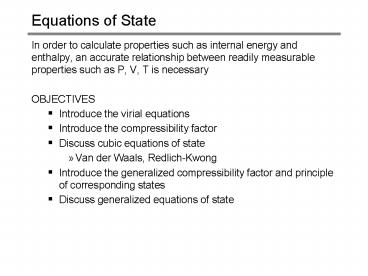Equations of State - PowerPoint PPT Presentation
1 / 16
Title:
Equations of State
Description:
isotherms of CO2. Virial Equations and Real Gases. Consider ... Along an isotherm, the diagram indicates that a polynomial equation can be used to describe PV : ... – PowerPoint PPT presentation
Number of Views:924
Avg rating:3.0/5.0
Title: Equations of State
1
Equations of State
- In order to calculate properties such as internal
energy and enthalpy, an accurate relationship
between readily measurable properties such as P,
V, T is necessary - OBJECTIVES
- Introduce the virial equations
- Introduce the compressibility factor
- Discuss cubic equations of state
- Van der Waals, Redlich-Kwong
- Introduce the generalized compressibility factor
and principle of corresponding states - Discuss generalized equations of state
2
Properties of Real Fluids - PV diagram
isotherms of CO2
3
Virial Equations and Real Gases
- Consider the gas region of a PV diagram. Along
an isotherm, the diagram indicates that a
polynomial equation can be used to describe PV - what happens as P ? 0?
- Real gases differ from ideal gases primarily
because of the existence of attractive and
repulsive forces.
4
Compressibility Factor, Z
- used to describe degree of deviation of gas from
ideal behavior
5
Cubic Equations of State
- Van der Waals equation (1873)
- included in the ideal gas equation the effect of
attractive-repulsive forces between molecules
6
Van der Waals Equation
- compare to the ideal gas equation
Volume occupied by molecules
Forces of attraction
7
Cubic Equations of State
- Van der Waals equation
8
Cubic Equations of State
- Redlich-Kwong Equation (1949)
- There have been many equations of state
published. In general
9
Principle of Corresponding States
- cubic equations of state make it possible to
solve problems for real fluids, if values for
parameters are given. - values for these parameters not available for all
fluids - to increase utility, need to be able to predict
these values - approach is to use generalized property
correlations - This approach is based on two findings
- Fluids can be grouped into classes based on their
properties and within any class molecular
interactions are similar. - If a given equation of state fits the data for
one member of a class, the same equation of state
will fit the data for other members of that class
10
Generalized Compressibility Factor
11
Generalized Equations of State
- Recall from the P-V diagram of fluids, at the
critical point, the isotherm undergoes an
inflection. Mathematically this can be expressed
as - consider the van der Waals equation of state at
the critical point
at Pc and Vc
12
Generalized Redlich-Kwong
13
Generalized Equations of State
- Van der Waals predicts that Zc 0.375, while
Redlich-Kwong predicts 0.333. - Zc for most fluids falls within the range 0.23 -
0.31.
14
Generalized Virial Equation
- Based on the use of the acentric factor, w, and
is only applicable to gases.
Z0 and Z1 can be found in tables or
15
EXAMPLE
- A 125 cm3 cylinder is rated at 200 atm. It
presently contains 1 mole of methane at room
temperature. If the temperature is raised to 50
ºC, will the cylinder rupture? Use the ideal gas
equation, and the Redlich-Kwong correlation.
16
Example
- Find the molar volume of methane at 280 K and
9.87 atm. Use the ideal gas equation, the
Redlich-Kwong equation, and the Generalized
Virial approach.































